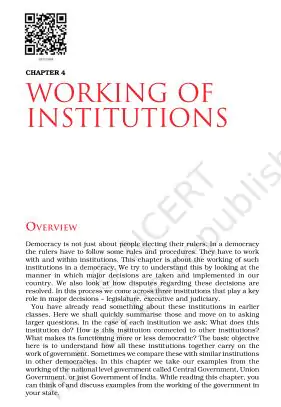‘Working of Institutions Class 9 Notes’ PDF Quick download link is given at the bottom of this article. You can see the PDF demo, size of the PDF, page numbers, and direct download Free PDF of ‘Working of Institutions Class 9 Notes’ using the download button.
Working of Institutions Class 9 Notes Book PDF Free Download

Working of Institutions Class 9 Notes
On August 13, 1990, the Government of India issued an Order which was called an Office Memorandum. The order says that other than SC and ST the 27% job reservation benefit will be given to a new third category called Socially and Educationally Backward Classes (SEBC).
Only persons who belong to backward classes were eligible for this quota.
The Decision Makers Who decided to issue this Memorandum? Such a major decision would have involved other major functionaries in India, which involves the following points:
1. The President is the head of the state and is the highest formal authority in India.
2. The Prime Minister is the head of the government and takes most of the decisions in the Cabinet meetings.
3. Parliament consists of the President and two Houses, Lok Sabha and Rajya Sabha. The Prime Minister must have the support of a majority of Lok Sabha members to pass a memorandum.
When the Office Memorandum was passed in India, it was a hot debate issue. Some felt that this was unfair as it would deny equality of opportunity to those who did not belong to backward communities.
While others felt that this would give a fair opportunity to those communities who so far had not adequately been represented in government employment.
dispute was finally resolved by the Supreme Court of India by hearing all the cases. This case was known as the ‘Indira Sawhney and others Vs Union of India case’. The Supreme Court judges in 1992 declared that this order of the Government of India was valid. Thus, the dispute came to an end and this policy has been followed since then.
Need for Political Institutions Several arrangements are made in modern democracies which are called Institutions. Democracy works well when these institutions perform functions assigned to them.
1. Institutions involve meetings, committees, and routines. This often leads to delays and complications.
2. Some of the delays and complications introduced by institutions are very useful as they provide an opportunity for a wider set of people to be consulted.
3. Institutions make it difficult to have a good decision taken very quickly. But, they also make it equally difficult to rush through a bad decision. Parliament Decisions are not directly taken in Parliament.
But Parliamentary discussions on the Report influence and shape the decision of the government.
These discussions bring pressure on the government to act. If Parliament is not in favor of the decision, then the Government cannot go ahead and cannot implement the decision.
Why Do We Need Parliament An assembly of elected representatives is called Parliament which exercises supreme political authority on behalf of the people.
At the state level, this is called the Legislature or Legislative Assembly. The name may vary in different countries, but such an assembly exists in every democracy. Parliament exercises political authority on behalf of the people in many ways as listed below:
1. Parliament is the final authority for making laws in any country.
2. Those who run the government can take decisions only when they get the support of Parliament.
3. Parliaments control all the money that governments have.
4. Parliament is the highest forum of discussion and debate on public issues and national policy in any country.
Two Houses of Parliament Most large countries divide the role and powers of Parliament into two parts which are called Chambers or Houses.
1. One House is usually directly elected by the people and exercises real power on behalf of the people.
2. The Second House is usually elected indirectly and performs some special functions. The most common work for the second House is to look after the interests of various states, regions, or federal units. In India, Parliament consists of 2 Houses.
The two Houses are known as: 1. The Council of States (Rajya Sabha)
2. The House of the People (Lok Sabha) The President of India is a part of Parliament, although he/she is not a member of either House. All laws made in the Houses come into force only after receiving the assent of the President.
Indian Constitution does give the Rajya Sabha some special powers over the states. But on most matters, the Lok Sabha exercises supreme power. Here are some points that illustrate this:
1. Any ordinary law needs to be passed by both Houses. But if there is a difference between the two Houses, the final decision is taken in a joint session in which members of both the Houses sit together. The view of the Lok Sabha is likely to prevail in such a meeting since there are a lot many members of the Lok Sabha.
2. Lok Sabha exercises more powers in money matters.
3. Lok Sabha controls the Council of Ministers.
| Author | – |
| Language | English |
| No. of Pages | 18 |
| PDF Size | 0.6 MB |
| Category | Notes |
| Source/Credits | ncert.nic.in |
Working of Institutions Class 9 Notes PDF Free Download
